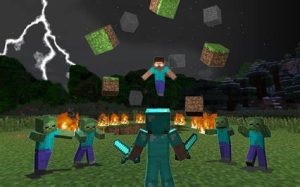Let everyone understand what is Gamification in education
Gamification in education is nothing new. It already existed in group tasks, house system and competitions. However, emergence of newer technologies rendering digital devices both versatile and easy to operate at the same time, have given a ‘play station’ in the hands of masses which has resulted in a phenomenal explosion of online gaming and individual as a one-man team.
For education, gamification is like any double-edged tool, which can’t be ignored. Addiction of online gaming is already of epidemic proportions hitting traditional learning every day. On the positive side, edutainment is shown to motivate students to learn and use multiple senses at a time. That is why experts have pegged gamification to be one of the top educational trends to watch out for in 2022.
A World Government Summit and Oxford Analytica report reveals that the appeal of gamification is encapsulated by four freedoms – the freedom to fail (make and learn from mistakes), the freedom to experiment (try out new strategies), the freedom of effort (periods of intense activity and reflection of accomplishments) and freedom to self-express (role-playing to understand different perspectives).
At its core, all games have three characteristics- they have a set of rules to be followed, a clear goal to be achieved, and an instant feedback mechanism. In a broad sense, gaming and learning have many similarities. Both involve exploring new areas, fixed objectives, gratification through rewards, collaboration, and competition, the ability to overcome obstacles/challenges, and time limits. As a learning tool, gamification combines learning, technology, and game design principles. In the era of microlearning, shortened attention spans, and retention issues, gamified learning can be an effective tool.
No matter even if gamification in education is small today, it is taking shaping and getting created on a daily basis around the world and it has to arrive. Newer technologies such as artificial intelligence, machine learning, virtual reality and augmented reality have already made their way to education and in years to come these technologies are going to create more sophisticated gamified learning environments in the future. Gamification can be a powerful aid for students particularly those who don’t adapt well to conventional learning methods. And some experts are of the view that conventional methods will become legacy soon as the hybrid learning becomes a norm and gamification a pedagogy.
Gamification is also about Automation of teaching processes, Personalisation of learning, Observed Progress or continuous monitored assessment, Interactive Learning and Soft skill development. Let’s briefly explain some of it:
Soft skill development
Improves or builds soft skills such as resilience, critical thinking, and problem-solving when game design elements of competition, collaboration, and role-playing are incorporated. These soft skills will later translate positively into the future job prospects of the learner in an increasingly competitive market.
Affinity for learning
The rewards/points/leaderboard elements of gamification generate a ‘high’ for the learner – similar to wins in football, cricket, etc., This feel-good factor encourages the learner to not only continue learning and imbibing knowledgebut also retain it for longer in the hopes of repeating the ‘high’.
Real-time feedback
Current feedback mechanisms like homework, projects, and exams have a long lead time for evaluation and feedback. The choices a learner makes in a gamified learning environment allows them to receive immediate feedback. The learner gets to know if their answer is right or wrong and if they are progressing in the right direction instantly. This allows the learner to improve and the teacher to implement corrective measures if required.
Fun and interactive learning
Gamification enhances the overall learning experience by tapping into the learner’s innate curiosity by making it exciting and entertaining. It also drives human engagement and productivity.
Real-world applications
Gamifying allows students to put their knowledge to practice and experience the real-world outcomes of their actions. This makes it easier to learn trickier, more practical subjects like maths, science, coding, etc.,

A few popular learning games of recent times
The one that comes to mind immediately is Duolingo. It’s a free language-learning app that allows learners to pick up a new language or test and improve their existing knowledge of a language. Courses in multiple languages are offered on the app and users can progress through levels, earn rewards and crowns, and compete in weekly challenges to climb the leader board.
Another popular game amongst children is Minecraft. Now, Minecraft: Education Edition has been introduced that allows teachers to onboard students onto a virtual, immersive, game environment and then teach them certain subjects. The plus point here is that the teacher controls the virtual environment and can set limitations.
If teachers are limited by monetary resources and technology, Kahoot is an ideal game-based learning platform to explore. The teacher can create a multiple-choice quiz on any topic on the website and circulate the quiz link to the class. Students then use their phones to answer the quiz in real-time, earn points, compete with their peers and make their way to the top of the leader board.
Read Along by Google, Brainscape, Quizlet are a few more.
The most important difference between regular games and educational ones is that the user has to have learnt new concepts or have their knowledge tested to make game progress in the latter.
Addictive nature of these games as a problem area
Gamification remains a controversial one, largely because it is perceived as being closely associated with traditional video games. The long-standing narrative around video games has been that they are addictive and a waste of time.
Yes, scoring points or earning rewards during gamified learning does generate a ‘high’ or dopamine spike for the learner which feels similar to the rush of winning a football match, a game of cricket, or winning a video game challenge. However, in gamified learning, this good feeling motivates the learner to continue to learn and retain knowledge to prolong their sense of achievement. Hence, the “addictive” attributes of games in gamification create positive reinforcement and an affinity for learning, unlike video games that promote mindless entertainment.
Also, all learners have a personal capacity for absorbing new information. And since gamification relies on the intrinsic motivation of the learner to learn a concept or complete a task, once the learner has reached their learning limit for the day they will stop. Another way to alleviate concerns of addiction is by introducing gamification slowly alongside traditional learning so that students continue to be exposed to real-world learning environments as well.
Games have a bad reputation for behavioral changes
Again, the content developed for gamified learning is purely educational and completely different from that of video games available in the market. All the material in gamification is designed to be safe for children and learner-friendly and free from violence, bad language, and mature themes that are cause for concern in video games. Parents have the opportunity to review the educational content being consumed by the student and to monitor the learning environment and teachers can decide the topic to be learnt.
Thus, it is difficult for students to be influenced negatively by education-related gamification and experience drastic behavioural changes. Instead, you can notice some positive changes in the learner – increased interest in learning, improved attention span, soft skill development, etc.,
A word for those who still see gamification as a big distraction and spoiler
The situation today is such that the present generation is born as digital natives. There has never been a time in their life when they have not been exposed to the phone or other digital mediums. It is impossible to keep them away from tech devices either. But as a parent, would you rather your child spends their time on the phone mindlessly scrolling through social media or playing games, or would you prefer they use the time spent on the phone wisely and learn something fun yet educational? This is something to consider.
The concept of games is familiar to children. Gamification in education allows them to challenge their mind from the convenience of their comfort zone (the game environment). Students feel a sense of control and empowerment. And teachers can simplify subjects that are hard to explain such as STEM or coding etc., Overall, gamification has the power to change lesson planning for schools.
Moreover, different students respond to different learning styles like audio, visual, social, etc., Gamification promotes an inclusive learning environment where there is something for every type of learner, ultimately ensuring the progress of all students.













